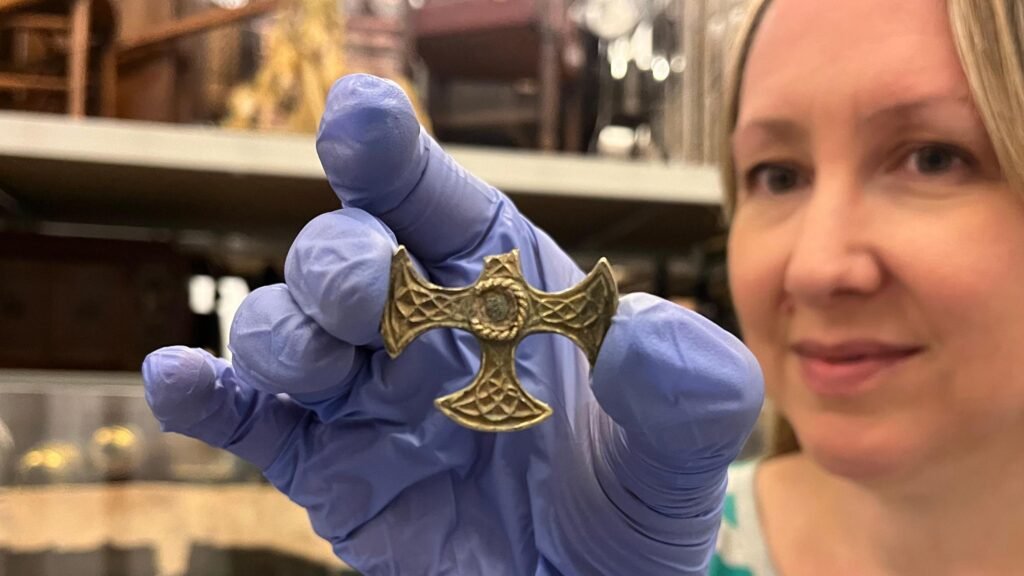Discovering History: The Saxon-Era Pendant Unearthed in Leeds

The Saxon-Era Pendant Unearthed in Leeds
Introduction to the Discovery
On April 18, 2023, archaeologists announced a remarkable discovery in the city of Leeds: a Saxon-era pendant estimated to date back to the 9th century. This exquisite piece of jewelry, which exemplifies the craftsmanship and artistry of the period, was unearthed during a routine excavation in a location linked to early medieval settlements. The pendant serves as a tangible connection to the lives and culture of the people who inhabited the region over a millennium ago.
This discovery is significant not only for its artistic value but also for its contribution to our understanding of local heritage. Artifacts like this pendant provide invaluable insights into the social dynamics, trade practices, and cultural exchanges that existed during the Saxon period. Such findings enrich historical narratives and highlight the importance of archaeological efforts in uncovering our past.
Moreover, the pendant’s intricate design features distinct motifs that are characteristic of Saxon jewelry, further strengthening its historical relevance. Similar artifacts have been uncovered in various parts of the UK, suggesting a network of connections through trade or movement among Saxon communities. Each new discovery adds a layer to the complex tapestry of history and reflects the intricate interplay between local cultures and broader historical events.
As the excitement surrounding this find grows, it serves as a reminder of the often hidden stories beneath our feet, waiting to be revealed through diligent exploration and research. In subsequent sections, we will delve deeper into the pendant’s specifics, contextual history, and the methods employed by archaeologists during the excavation. Understanding the significance of such discoveries fosters a greater appreciation for the rich cultural landscape of Leeds and reminds us of the enduring legacy of the Saxon era.
The Significance of Saxon-Era Artifacts
Saxon-era artifacts hold immense significance for historians and archaeologists, offering valuable insights into a transformative period in British history. The Saxon period, spanning from approximately the 5th to the 11th centuries, was marked by significant socio-political changes following the decline of Roman influence. These artifacts, such as the recently unearthed pendant in Leeds, serve as tangible connections to the past, revealing the intricate cultural and societal structures of the time.
The craftsmanship evident in Saxon artifacts illustrates the advanced skills of artisans during this era. Jewelry, tools, and domestic items were crafted not just for utility but also for aesthetic appeal, reflecting the values and beliefs of Saxon society. The pendant itself is likely to provide clues about trade relations and social hierarchies, as it may have served as a status symbol or a religious talisman. Each piece offers a narrative that helps historians piece together the daily lives, customs, and identities of Saxons, enriching our understanding of this historical period.
Furthermore, Saxon artifacts reveal the influences that shaped the culture in Britain, including the interactions with Viking invaders and other neighboring cultures. This exchange of ideas and materials contributed to the development of the Anglo-Saxon identity, which is fundamental in understanding the roots of modern British society. By studying these artifacts, researchers can trace the evolution of social structures, technological advancements, and spiritual beliefs during the Saxon era, highlighting the period’s complexity. In summary, the significance of Saxon-era artifacts extends far beyond their physical attributes; they are essential for unraveling the intricate tapestry of history that contributes to our collective heritage.
The Process of Discovery
The recent unearthing of a Saxon-era pendant in Leeds provides a remarkable glimpse into our shared heritage, showcasing not only the value of the artifact itself but also the sophisticated methods employed during its discovery. This pendant was discovered by an amateur metal detectorist, a hobby that has gained popularity in recent years, often resulting in significant finds that enrich our understanding of history.
Modern metal detecting utilizes advanced technologies that enhance the accuracy and efficiency of locating buried treasures. One key aspect involves the use of high-frequency metal detectors, which can detect even the smallest metallic objects buried deep beneath the surface. These detectors often include features such as discrimination settings, allowing the operator to differentiate between various types of metal. This enables them to identify historic items while avoiding modern debris. Additionally, GPS technology plays a crucial role, helping detectorists to pinpoint exact locations and document their finds accurately.
Despite the excitement surrounding metal detecting, responsible practices are paramount to preserving historical integrity. Detectorists must adhere to the legal framework surrounding artifact discovery, which often requires obtaining permission from landowners and reporting significant finds to local authorities. The Portable Antiquities Scheme (PAS) in the UK encourages metal detectorists to record their findings, contributing to a national database of archaeological discoveries. This practice not only aids in the protection of heritage sites but also ensures that artifacts such as the Saxon pendant are studied properly, adding to the rich tapestry of historical knowledge, rather than being lost or misappropriated.
In conclusion, the pendant’s discovery serves as a testament to both technological advancements in metal detecting and the importance of responsible practices in archaeology. By combining passion with ethics, we can continue to uncover and appreciate the treasures of our past.
Details of the Pendant
The recently unearthed Saxon-era pendant from Leeds exemplifies the intricate craftsmanship characteristic of the period. Measuring approximately three inches in diameter, the pendant showcases a circular design that draws immediate attention with its elaborate motifs. The primary material is believed to be a combination of bronze and gold, a choice of metals that reflects the status and artistry of Saxon artisans. Such materials were often utilized to convey both aesthetic beauty and social standing among the Saxon elite.
Upon closer examination, the pendant reveals several engravings and embossed floral patterns that likely held significant meaning during the Saxon era. The intricate floral design may symbolize fertility or life, common themes in Anglo-Saxon art that closely intertwined with the culture and religious beliefs of the time. These motifs are indicative of an era that embraced natural symbolism in their decorative arts, providing insights into the beliefs and values of the Saxon people.
In addition to the decorative elements, the pendant has been found to feature inscriptions etched into its surface. These inscriptions, although partially worn from the passage of time, appear to be written in Old English runes. The significance of these inscriptions could range from personal dedications to indications of ownership, reflecting the importance of identity in Saxon society. The use of runes suggests that the pendant carried not only visual beauty but also personal or spiritual significance for its wearer.
Overall, the pendant is a remarkable artifact that encapsulates the artistry, cultural beliefs, and socio-political structures of the Saxon era. Each element of its design provides valuable clues, allowing historians and archaeologists to better understand the craftsmanship and symbolic language of this fascinating period in history.
The Role of Local Archaeological Groups
Local archaeological groups play a crucial role in the preservation, understanding, and celebration of historical artifacts and sites. These societies are often composed of volunteers and enthusiasts who are deeply passionate about uncovering and interpreting the past. A prominent example of their impact can be seen in the collaboration with metal detectorists, who frequently discover objects that might otherwise remain hidden beneath the soil. This partnership fosters a sense of community that encourages individuals to engage with local heritage actively.
By working with metal detectorists, local archaeological societies help ensure that finds are reported and analyzed properly. This collaboration enhances the opportunities for academic research and public education surrounding historical artifacts, such as the Saxon-era pendant discovered in Leeds. Through meticulous documentation and study, these groups not only safeguard the integrity of the relics but also contribute to a broader understanding of the era in which they were created. Active participation from local citizens aids in building a comprehensive narrative of an area’s history, linking contemporary communities with their ancestral roots.
In conclusion, the synergy between local archaeological societies and metal detectorists exemplifies cooperative heritage management, ensuring that historical findings are not only celebrated but also preserved for future generations. Through their dedication and commitment, these groups promote community engagement and raise awareness about the importance of protecting our collective past.
Historical Context: Life in Saxon England
The Saxon period in England, spanning from the 5th to the 11th century, marked a significant transformation in the cultural and social landscape of the region. This era began with the arrival of Germanic tribes, including the Angles, Saxons, and Jutes, who displaced the native Celtic population. Over time, these groups established a series of kingdoms, each governed by its own king, and collectively contributed to the development of what we now recognize as English society. The formation of these kingdoms, such as Wessex, Mercia, and Northumbria, was intrinsically linked to various social structures that defined Saxon life.
Within Saxon society, hierarchical systems were prominent. At the top were the kings and their aristocracy, who commanded loyalty and military service from their thanes, or nobles. Below them were freemen, often farmers or artisans, who owned their land and could engage in trade. The lowest strata were the serfs, who worked the land on behalf of their lords and often lived in servitude. Social mobility was limited; however, the era was characterized by significant cultural and technological advancements, particularly in agriculture, metalworking, and trade.
Everyday life for a Saxon individual varied significantly depending on their social standing. Farmers cultivated crops such as barley and wheat, while craftsmen produced goods including pottery and textiles. The community played an essential role in ensuring survival, with local halls serving as centers of social and political life. Religious beliefs were equally important; paganism eventually gave way to Christianity, which profoundly influenced art, education, and law during the latter part of the Saxon period. Artifacts such as the recently unearthed pendant from Leeds contribute valuable insights into these social dynamics, illustrating not only the craftsmanship of the time but also carrying cultural significances that resonate throughout British history.
Public Response and Community Involvement
The recent discovery of a Saxon-era pendant in Leeds has ignited considerable excitement among residents, historians, and archaeology enthusiasts alike. The profound historical significance of the pendant has sparked a variety of public reactions, transforming the find into a focal point for community engagement. Local schools, history groups, and cultural organizations have taken the initiative to educate citizens about this invaluable piece of heritage, highlighting the connection it provides to the area’s Saxon past.
Interest in the discovery has transcended mere curiosity; it has fostered a strong sense of pride within the community. Several events have been organized to celebrate the pendant’s unveiling, including public lectures, exhibitions, and interactive workshops. Local museums, in collaboration with historical societies, have made efforts to include the pendant in ongoing exhibitions, thereby emphasizing the importance of preserving and understanding local history. These events not only educate but also encourage active participation from community members of all ages.
Social media platforms have also played a crucial role in galvanizing interest, with many residents sharing information about the pendant and discussing its significance. Online forums have seen discussions debating the implications of such findings on our understanding of local history, further engaging those who may not have previously considered the relevance of archaeological discoveries.
Moreover, local authorities have recognized the need to capitalize on this enthusiasm. Plans to incorporate educational programs about the Saxon era into the school curriculum are currently in discussion. This approach aims to cultivate an appreciation for local heritage and instill a sense of responsibility towards preserving historical artifacts for future generations.
Future of Archaeological Discoveries in Leeds
The rich tapestry of history in Leeds promises significant potential for future archaeological endeavors. As urban expansion continues, the area remains a hotspot for uncovering artifacts that speak to its Saxon heritage and beyond. Archaeologists are particularly keen on exploring sites that have yet to be excavated or thoroughly studied. Areas known for their historical significance, such as the River Aire bank and ancient marketplaces, hold much promise for revealing new insights into local life during the Saxon era.
Moreover, with advancements in technology, the future of archaeology in Leeds looks particularly bright. Tools such as ground-penetrating radar (GPR) and aerial Lidar are revolutionizing how archaeologists identify potential dig sites without extensive excavation. GPR, for instance, allows researchers to map subsurface structures, leading to more informed decisions about where to dig. This precision not only saves time and resources but also minimizes disruption to the historical landscape, fostering a more sustainable approach to archaeological practice.
The integration of digital technologies into the public domain could further enhance archaeological efforts. Virtual reality (VR) and augmented reality (AR) can be employed to create immersive experiences for the public, allowing individuals to engage with Leeds’ rich history while promoting greater awareness and interest in local heritage. Educational institutions and civic bodies can collaborate to maximize the impact of such technologies, encouraging community participation in archaeological endeavors.
As the demand for historical engagement grows, it is likely that Leeds will see increasing investment in archaeological research. This trend could lead to a new era of exciting discoveries, ensuring that the history buried beneath the surface continues to enrich our understanding of past societies. As researchers and enthusiasts look toward the future, the potential for unveiling more of Leeds’ rich historical narrative remains vast.
Conclusion: Embracing Our Heritage
The recent discovery of the Saxon-era pendant in Leeds represents a significant milestone in our understanding of local history. This remarkable artifact not only exemplifies the craftsmanship and artistry of the Saxon period but also serves as a tangible link to our past, allowing us to reflect on the lives of those who once inhabited this region. Such finds are crucial in illuminating the social, cultural, and economic practices of early civilizations, offering insights that textbooks alone cannot provide.
As we delve into the implications of this discovery, it becomes apparent that the pendant stands as a symbol of our shared heritage, encouraging us to embrace the stories that shape our identity. Each artifact unearthed in our communities can foster a renewed appreciation for the rich history that lies beneath our feet. The pendant is not merely an object; it is a testament to the value of preserving our historical sites and artifacts. By engaging with these elements of our heritage, we help to keep the narrative of our past alive for future generations.
Furthermore, this discovery highlights the importance of archaeological endeavors and the potential for future finds in Leeds and beyond. It invites us to consider the archaeological landscape and the ethical responsibility we bear in safeguarding our historical treasures. Protecting such artifacts is essential, as they provide a window into the complexities and nuances of human civilization and encourage a sense of continuity. By fostering a collective responsibility to appreciate and preserve our history, we can ensure that future discoveries continue to enrich our understanding of the past.
In conclusion, the Saxon-era pendant serves as a reminder of the importance of heritage, urging us to cherish, protect, and learn from the rich history embedded in our communities. Let us look forward to what future discoveries may unveil, as we continue to explore and embrace our shared heritage.











Leave a Reply
You must be logged in to post a comment.